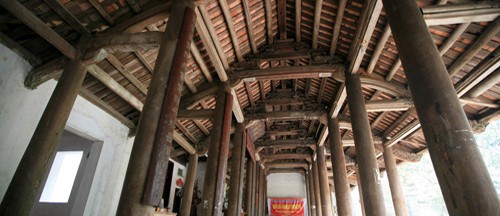While Can Duoc-Long An is famous for its high-quality rice, it is also known as a cultural institution for of its Hundred-Column House which is considered an architectural masterpiece in Long Huu Dong.
The Hundred-Column House was built between 1901-1903 and owned by Mr. Tran Van Hoa, a village headmaster at Long Huu Village, Loc Than Ha Canton, Cho Lon Province. Central Vietnamese workers helped construct the house which is generally designed with traditional architectural Vietnamese elements.
The house is located at a garden with an area of 4,044 meter square, and the house itself 882 meter square big and shaped like the letter “Quoc.”. The structure is divided into two parts, the front and the back. The former is master-guest area while the latter is the residential portion of the house. The house is composed of three compartments and two lean-tos and made from the wood Dalbergia, Afzelia xylocarpa, Sindora saimensis. The roof is made of Yin and Yang tiles to achieve balance. The floor is made of carved stones while its surface is made of hexagon-shaped Chinese tiles. The frame is sturdy with its eight posts positioned in the West-East and front-back portions of the structure. The ridge-beam of the roof is supported with a mortar and pestle-shaped, Yin and Yang frame which is considered strong and reliable because of the balance of the latter two. There is a space in the middle of the house called “broad-minded.” The original structure built a back rice storehouse but it was removed in 1952.
While the house is built with traditional architectural details, the interior is designed with elaborate wood carvings which are said to be a blend of both Hue style and French influence. The frames are carved with such intricate designs as “Cloud Into Dragon” and “The Four Seasons.” The Master and guest areas are sculpted with ancient pictures of “The Four Supernatural Creatures,” “The Four Seasons” and “Eight Fruits,” as well as symbols of wealth and longevity which are considered types of happiness. Varied areas of the house are carved with Western elements like grapes, squirrel and rose; and Southern themes such as apple, custard, thistle and mangosteen using the bass-relief technique.Balconies, partitions, frames, altar, and even chairs and tables are filled with complicated yet beautiful carvings. The overall result is a fascinating yet equally calming effect to anyone who gazes at the intricate work.
Its intricate design, precise attention to details and preservation of Vietnamese culture has made the Hundred-Column House earn the prestigious title of National Historic-Cultural Vestige by the Ministry of Culture and Information. It’s a historical and cultural vestige that will be appreciated by people from all over the world and last for generations to come.

